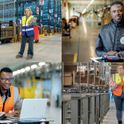
This feeling is understandable. Yet no organisation, and no industry as a whole, can avoid the necessity of preparing for the future. This is especially pertinent in a world of high uncertainty and fast-paced change. It has become more important than ever to have the best possible understanding of the socio-economic and technological change at play around us, so that we can prioritise and adapt effectively.
This is where horizon scanning, the “systematic gathering of intelligence on future opportunities and threats,” comes in. By putting emerging technologies, societal trends and potential disruptions on our radar, analysing their likely impact on the rail sector and on transport in general, and developing alternative scenarios, horizon scanning enables the industry to look ahead and plan proactively how to exploit or mitigate future changes. This makes our long-term strategies more resilient and helps us secure the most positive outcome for our organisations. I also believe that horizon scanning can lead industry decision makers to develop new insights and think outside the box, which is crucial for the railway to embrace innovation and keep pace with the needs and choices of its customers.
To help the rail industry access the benefits of strategic foresight, RSSB systematically monitors a wide range of information sources and indicators, with the intent of identifying patterns and ‘weak signals’ of coming disruptions that could have a severe or a transforming impact on rail. I primarily think of the emerging technologies that can enable the delivery of the Rail Technical Strategy (RTS), and the socio-economic trends that can affect future transport demand and the rail industry’s future competitiveness. For instance, driverless technologies can be seen as a potential threat to rail, supporting individual over mass transport, but these technologies can also enable the future vision of intelligent trains running closer together, and provide a new and different solution to the challenge of supporting the last mile of people’s journeys. What about Hyperloop? How will climate change impact the rail industry? How is remote working and the gig economy already transforming passenger demand? What can Augmented Reality and Virtual Reality do for us? These questions are some of the topics that horizon scanning addresses.
We have uploaded on our website Emerging Technology Briefs which recap in just two pages what each emerging technology that we have put on our horizon scanning radar is, its technology readiness level, what other sectors use it, its potential applications to rail, what uncertainties remain, what research is being conducted, and so on.
We will do the same over the next year with selected socio-economic trends that are likely to impact our industry. Right now, the technology assessments available on RSSB’s website cover the fields of advanced materials, energy, sensors/connectivity, and intelligent systems.
We also conduct “deep dives” and publish a series of blog posts called “over the horizon” to raise the rail industry’s awareness of key topics. Our first series brought together the voice of safety experts, railway operations professionals, human factor specialists, technologists and economists to look at the impact of automation on the railway. Subsequent series have covered future rail talent, and future use of wearable technologies for staff health and safety. Our next campaign will look into machine learning and its best applications to rail, as our horizon scanning has established machine learning’s particular importance for the future railway, from disruption forecasting, timetabling optimisation, and risk analysis, to personalised passenger experience.
These are just a few examples of what horizon scanning endeavours to encompass. “By failing to prepare, you are preparing to fail“, as Benjamin Franklin famously said – this is as true as for tomorrow as for a more distant future, and why horizon scanning is needed.
Read more from "The Future of Transport"












